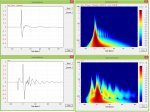Re: Infocomm???
That looks fantastic Mark – I’ve taken a guess at the rest of the specs; want some of those drivers J
I built a new 18" long excursion Dual-VC speaker for McCauley last year, 1.6" Winding, 0.3" top-plate.
These were the unprocessed results from a good ole' front loaded double 18" cabinet 2.0V @ 1m.
View attachment 12717
I was actually really surprised how easy it was to build a speaker which could hit 32Hz. Although I don't have the time or a customer for it right now, I'm pretty interested in carrying it further with a longer under-hung motor design.
I've done up a few FEM models of what I'd like to build to get the linear region up to ~2.0" without significantly reducing the power handling or sensitivity. Of course, if you want to move that cutoff frequency down significantly the sensitivity will have to go down. Moving to the under-hung design you don't need Dual-VC anymore for symmetry; TC sound has a few motors like this on the market, but they aren't really targeting Pro-Audio.
The main issue with me just throwing one together and measuring it, is that I need to machine some specialty parts for magnetization.
That looks fantastic Mark – I’ve taken a guess at the rest of the specs; want some of those drivers J


